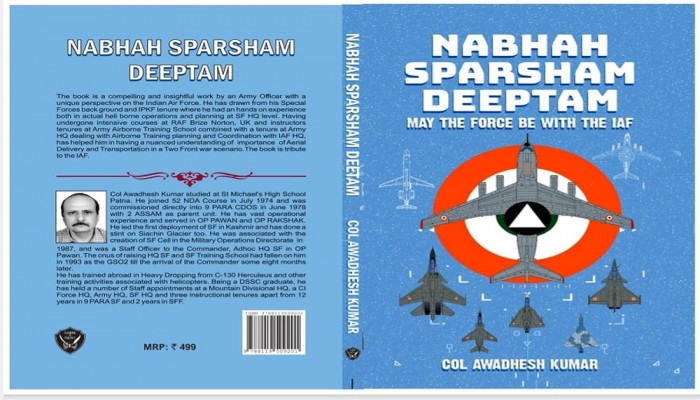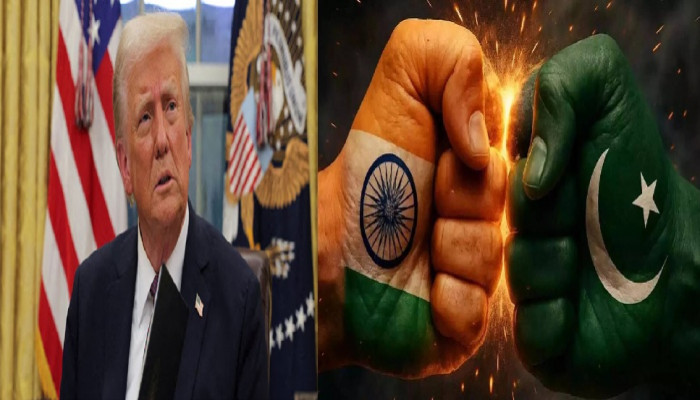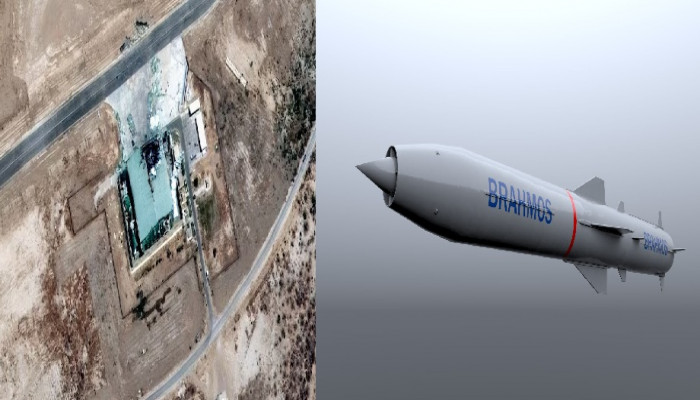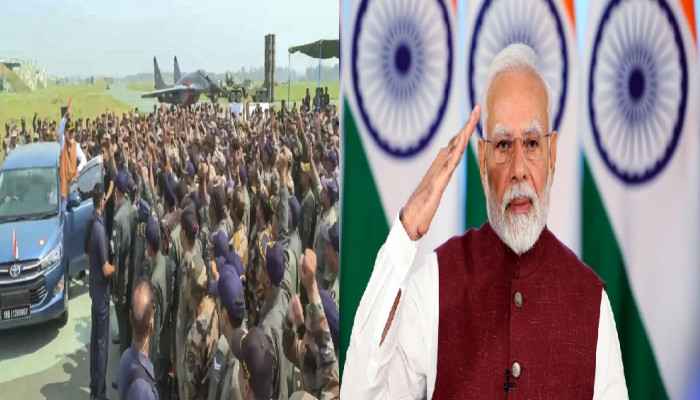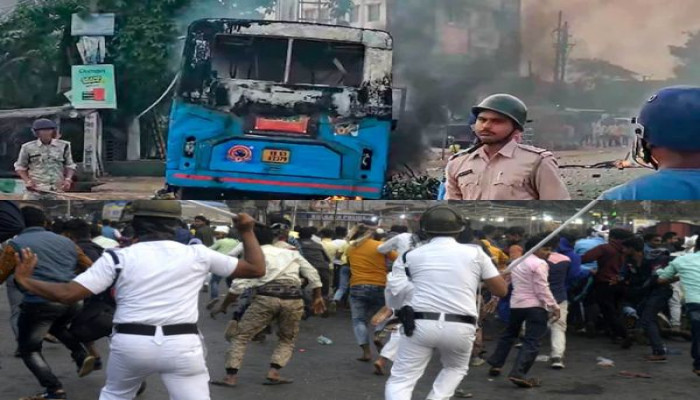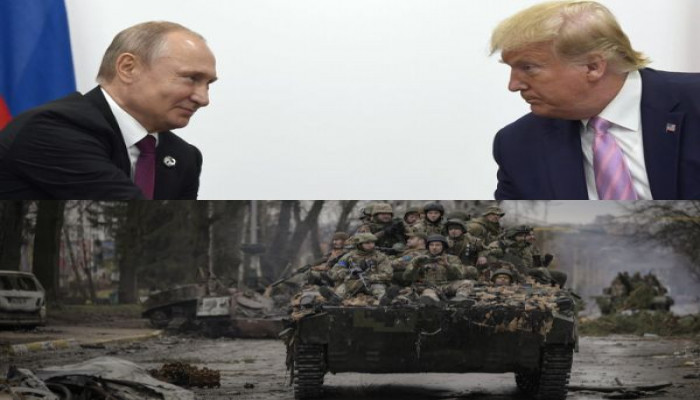- May 20, 2025
- Venkataraman Ganesan
Featured Articles
Nabah Sparsham Deeptam: May the Force Be with the IAF
The resounding success of Operation Sindoor[1], in addition to demonstrating the resilience and preparedness of the Indian Armed Forces, has also served up a stirring tribute to the burgeoning strides undertaken by Bharat in furthering innovation and ingenuity in the realms of science & technology in general, and modernisation of defence in particular[2]. A pulsating, vibrant military-industrial ecosystem, having at its edifice a robust public-private partnership, has ensured enviable progress in some of the advanced domains of unconventional warfare, such as drone/Unmanned Aerial Vehicle (UAV) deployment and aerospace defence. While reams have been expended – and rightly so -in waxing eloquent over the tremendous capabilities that smeared humiliation on the collective faces of Messrs Asim Munir and Shehbaz Sharif, one would do well to ponder on what more can and should be done in order to bolster the physical and logistical might of our gallant forces. In 2023, Colonel Awadhesh Kumar did just that, concentrating on one arm of the troika constituting our vaunted Armed Forces – The Indian Air Force (IAF). Meticulously researching the current inventory of our flying fortresses, Col Kumar did a book-length SWOT analysis, identifying strengths as well as directing attention towards potential chinks in the armour. Prior to wading into the nuts, bolts and brass tacks of the book, here is a caveat. The book is an agglomeration of articles published by the author spanning 2019 – 2023. While a considerable quantum of water has since flown under the bridge (the volatile tinder box that is the current representative state of Bangladesh[3], additional Rafales to the existing squadrons[4], and of course, the Pahalgam massacre[5] followed by Operation Sindoor etc), the basic tenets that hew the bulwark of the author’s analysis remain significantly relevant. The salient takeaways of Nabah Sparsham Deeptam can be summarised under the following broad headings: Urgent need to bolster squadron strength. Col Kumar, bemoaning the current inadequacy in terms of squadron strength of the IAF calls for urgent reinforcement measures to be instituted. According to his calculations, thirty squadrons, at a minimum, are required for preserving a pure “gapless” defence encompassing the entire Indian airspace. This combined with the fact that India needs to be prepared at all times to wage an insidious two-front war, means that to hold both fronts formidably, while enabling deep strikes into the hearts of the twin invaders, IAF would need 63 squadrons, a far cry from both the currently sanctioned 42 squadrons and the existing depleted fleet of 31 squadrons. In the opinion of Col Kumar, this yawning gap between what is available and what is optimally required can be bridged by a combination of urgent acquisitions of aircraft in “flyway conditions” and progressive/graded Make In India[6] initiatives under the Atmanirbhar Bharat[7] aegis. Col Kumar makes a compelling argument for the following “line-up” in terms of squadron strength by 2040: 12 Squadrons of Advanced Medium Combat Aircraft (AMCA) 15 Squadrons of Sukhoi 30 MKI (SU 30 MKI) 15 Squadrons of TEJAS MK 2/MK 1 A 6 Squadrons of TEJAS MK 3 6 Squadrons of Rafale 6 Squadrons of Sukhoi 57 MKI (SU 57) 3 Squadrons of Mirage 2000 (retiring) The intransigence of Hindustan Aeronautics Limited (HAL) ‘Cordial’ is not the word that spontaneously comes to mind when articulating the relationship between the IAF and India’s premier Public Sector Undertaking (PSU) in the defence sector, HAL. In February 2025, Air Chief Marshal Amar Preet Singh hurled a stinging salvo at HAL when he expressed his doubts on the delivery capabilities of the latter. This vitriolic comment was made in the light of inordinate and inconceivable delays in the supply of the Tejas Light Combat Aircraft (LCA) to the IAF by HAL.[8] As informed by Col Kumar, this intransigence of HAL is an endemic and systemic phenomenon. HAL and the IAF were engaged in a protracted battle over the future of the HTT-40 trainer aircraft programme at least a decade ago. The IAF steadfastly refused to accept a sub-standard, unproven and unsafe aircraft foisted upon it by HAL. Unacceptable delays and cost escalations later, the then Defence Minister, A.K. Antony, was forced to place orders for 75 Swiss Pilatus PC-MK II trainers. This was when the requirement was for approximately 183 trainer aircraft. Even before the conception of the HTT-40 programme, HAL had covered itself in infamy with the HPT-32 project, yet another training programme saga. Unproven technologies resulted in the perfectly avoidable deaths of 19 pilots. India was forced to ground the entire HPT-32 trainer aircraft following these unfortunate and tragic incidents[9]. In 2015, the newly formed Narendra Modi Government finally cracked the whip with a ‘perform or perish’ diktat. A young team accepted the government’s challenge and more than just rose to the occasion. Almost 50 percent of the components of HTT-40 are now sourced indigenously from the private sector. At the time of writing, HAL is expected to commence deliveries of TEJAS Mk-1A to IAF by the end of 2025[10]. Need for ‘Force Multipliers.’ Apart from the state-of-the-art fighters, there is a telling need for the IAF to equip itself with what Col Kumar terms ‘Force Multipliers.’ These include Airborne Early Warning and Control Aircraft Systems (AWACS), Aerial Refuellers, Electronic Warfare aircraft, very long-range radars, and medium-range air defence missiles. There is an alarming deficit in this sphere, especially in terms of AWACS, as Col Kumar illustrates. When the book was published in 2023, the IAF possessed just three PHALCON AWACS systems based on the IL-76 aircraft, operating in tandem with two indigenously built Netra Systems mounted on Embraer aircraft. A woefully inadequate number when the optimal requirement, considering India’s holistic needs, is a jaw-dropping thirty-six! Even Pakistan possesses nine AWACS, a tally that might have been reduced by one after India’s devastating strikes on Pakistani air bases following Operation Sindoor. At the time of this review, the IAF has embarked on a programme to procure 12 additional airborne early warning (AEW) aircraft, along with another platform for undertaking special missions[11]. Similarly, a meagre strength of ten C-17 aircrafts, puts a strenuous and Herculean load on the country’s strategic airlift capability. Col Kumar recommends pressurising the United States to sell twenty-five C-17s from their reserves to bolster the capability of IAF. Col Kumar also issues a clarion call for an urgent reinforcement of seventy, fifty, twenty and ten-tonne payloaders, in addition to two-tonne light lifters. Indian Defence Accounts Services (IDAS) Apathy The former late Minister of Defence Shri Manohar Parrikar, in completely good faith and with good intent, appointed a Committee for identifying improvements in the ‘TEETH TO TAIL RATIO’, which would have as its outcome, a significant reduction in revenue expenditure, which in turn, would pave the way for a corresponding increase in capital expenditure. Even before the first meeting of the Committee, the IDAS issued a statement that read more like an indictment than an elucidation of facts. “The Accounts Branch of IAF has 492 members and 7000 men catering to Pay & Allowances matters of all ranks of IAF numbering 160000. On a competitive note, the same can be provided by three hundred people on the civilian side very easily.” This preposterous statement completely ignores the fact that IAF personnel are deployed with all the wings and in all support bases, including some extraordinarily remote locations such as Leh, Uttarlai etc. It should come as no surprise, therefore that while the average annual expenditure on a military pensioner is around INR 1.5 lakhs, the corresponding amount for a civilian pensioner is INR 5.38 lakhs! Aiming for the frontiers of Space On 27 March 2019, India produced a stupendous exhibition of an Anti-satellite weapons technology (ASAT)[12] by blowing to smithereens a satellite (specifically manufactured for this exercise) in a low orbit altitude of three hundred kilometres[13]. This astonishing achievement, codenamed Project Shakthi, was the culmination of Lieutenant General Hardev Singh Lidder’s prescience. Chief of Staff to the Chairman, Chief of Staff Committee (CISC), the visionary Lt Gen Lidder harboured a futuristic ambition of an integrated tri services Space Agency which had as its components both DRDO and ISRO. India now, under the stewardship of Prime Minister Narendra Modi has a Defence Space Agency as well as a Defence Cyber Agency. This Agency, according to Col Kumar would be entrusted with the responsibility of working on directed energy ASAT weapons, co-orbital ASAT weapons, lasers and Electro Magnetic Pulse (EMP) based ASAT weapons. The future holds some exciting prospects both for the agency as well as for the nation. Nabah Sparsham Deeptam packs some explosive nuggets of wisdom within its covers, and one would do well not to be deceived by the slimness of the book. Col Kumar, exacerbates, accentuates and embellishes the tried and tested philosophy which asserts the importance of quality over quantity. The book also reveals the undying patriotism that throbs unceasingly and unrelentingly in the heart and soul of a serviceman, most of whose life is spent in the unflinching and unyielding service of the nation. JAI HIND! Printed Pages: 154 Kindle Edition 1. Operation Sindoor: Understanding Context and Consequence 2. Operation Sindoor: Technology In Action - Taazakhabar News 3. Bangladesh Coup: How Army staged the ouster of Sheikh Hasina 4. India Orders 26 Rafale Marine carrier-based aircraft for $7.5 billion - Naval News 5. Pahalgam terror attack: Is Pakistan behind the massacre of 26 people? – Firstpost 6. Make In India 7. Aatmanirbhar Bharat | Azadi Ka Amrit Mahotsav, Government of India. 8. IAF chief lack of trust in HAL is alarming - IAF chief lack of trust in HAL is alarming PM and Defence Minister must step in Opinion - India Today 9. India Grounds HPT-32 Trainer Aircraft After Crash - Airforce Technology 10. HAL to start deliveries of Tejas Mk-1A to IAF by end of 2025; GE and HAL discuss ToT for engines - Business News | The Financial Express 11. IAF procuring 12 AWACS, one special role aircraft to overcome limited surveillance capability - The Tribune 12. The Proliferation of Anti-Satellite (ASAT) Weapons: An Overview - Modern Diplomacy 13. Frequently Asked Questions on Mission Shakti, India’s Anti-Satellite Missile test conducted on 27 March, 2019- May 18, 2025
- Madhu Hebbar



